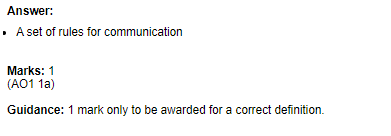1.3.2.5 Protocols
Introduction: In the world of computer networks, data is transferred between devices using a set of rules known as communication protocols. These protocols define the format of data packets, how they are transmitted, and how they are received. In this study guide, we will explore the principle of communication protocols and their significance in computer networks.
Section 1: What is a communication protocol? A communication protocol is a set of rules that governs the exchange of data between devices in a computer network. It provides a standard way for devices to communicate with each other, ensuring that data is transmitted and received correctly. Communication protocols can be either hardware or software-based, and they determine the specific format of data packets, how they are transmitted over the network, and how they are interpreted by the receiving device.
Section 2: The significance of communication protocols Communication protocols are essential to the functioning of computer networks, as they ensure that devices can communicate with each other seamlessly and efficiently. Without protocols, devices would not be able to interpret each other's data, resulting in communication breakdowns and lost information. Protocols also enable devices from different manufacturers to communicate with each other, allowing for a more diverse and adaptable network.
Section 3: Types of communication protocols There are many different types of communication protocols, each designed for specific types of data transfer and network configurations. Some of the most common types of protocols include TCP/IP, HTTP, SMTP, and FTP. TCP/IP is used for most internet communication, while HTTP is used for web browsing. SMTP is used for email communication, and FTP is used for file transfers.
Practice Questions:
- What is a communication protocol, and why are they important in computer networks?
- Name three types of communication protocols and explain their uses.
- What happens if devices on a network are not using the same communication protocol?
- How do communication protocols enable devices from different manufacturers to communicate with each other?
- Give an example of a situation where a specific communication protocol would be necessary.
Answers:
-
A communication protocol is a set of rules that governs the exchange of data between devices in a computer network. They are important in computer networks because they ensure that devices can communicate with each other seamlessly and efficiently, allowing for a more diverse and adaptable network.
-
Some of the most common types of communication protocols include TCP/IP, HTTP, SMTP, and FTP. TCP/IP is used for most internet communication, HTTP is used for web browsing, SMTP is used for email communication, and FTP is used for file transfers.
-
If devices on a network are not using the same communication protocol, they would not be able to interpret each other's data, resulting in communication breakdowns and lost information.
-
Communication protocols enable devices from different manufacturers to communicate with each other by providing a standard way for devices to communicate with each other, ensuring that data is transmitted and received correctly.
-
An example of a situation where a specific communication protocol would be necessary is when sending an email, as it requires the use of the SMTP protocol to transmit the message from the sender to the recipient's email server.
Common Protocols
TCP/IP: Transmission Control Protocol/Internet Protocol (TCP/IP) is one of the most common communication protocols used in computer networks. It is responsible for sending and receiving data over the internet, and it ensures that data is transmitted reliably and efficiently.
HTTP and HTTPS: Hyper Text Transfer Protocol (HTTP) and Hyper Text Transfer Protocol Secure (HTTPS) are communication protocols used for web browsing. HTTP is used to transfer data from a web server to a web browser, while HTTPS is used to secure the data transfer and protect it from potential eavesdropping.
FTP: File Transfer Protocol (FTP) is a communication protocol used for transferring files between computers on a network. It allows for easy and efficient file sharing across different devices.
POP, IMAP, and SMTP: Post Office Protocol (POP), Internet Message Access Protocol (IMAP), and Simple Mail Transfer Protocol (SMTP) are communication protocols used for email communication. POP and IMAP are used for receiving emails, while SMTP is used for sending emails.
Practice Questions:
- What is a communication protocol?
- Why is understanding communication protocols important in computer networks?
- What is TCP/IP and what is its role in computer networks?
- What is the difference between HTTP and HTTPS?
- What is FTP and what is it used for?
- What are POP, IMAP, and SMTP, and what is their role in email communication?
Answers:
- A communication protocol is a set of rules that governs the exchange of data between devices in a network.
- Understanding communication protocols is important in computer networks to ensure that devices can communicate with each other seamlessly and efficiently.
- TCP/IP is a common communication protocol used in computer networks. It is responsible for sending and receiving data over the internet, ensuring that data is transmitted reliably and efficiently.
- HTTP is used to transfer data from a web server to a web browser, while HTTPS is used to secure the data transfer and protect it from potential eavesdropping.
- FTP is a communication protocol used for transferring files between computers on a network, allowing for easy and efficient file sharing across different devices.
- POP, IMAP, and SMTP are communication protocols used for email communication. POP and IMAP are used for receiving emails, while SMTP is used for sending emails.
Past Paper Questions



